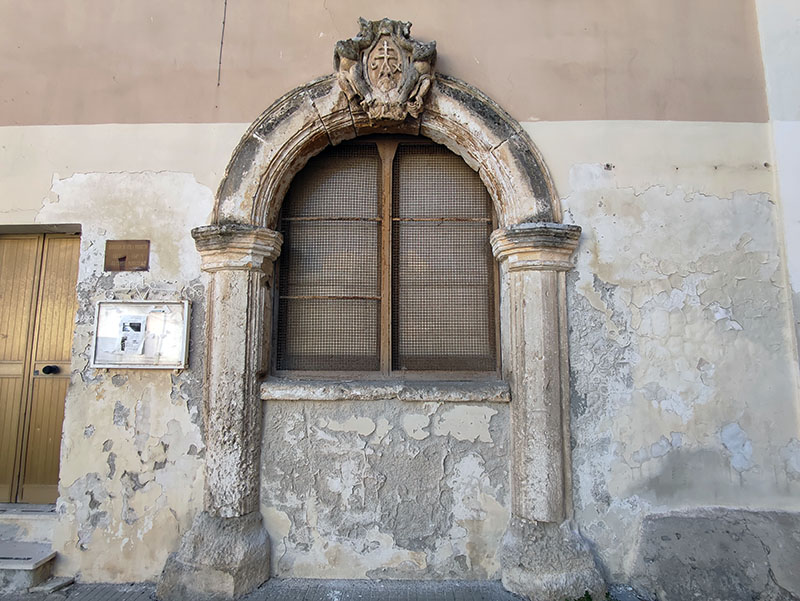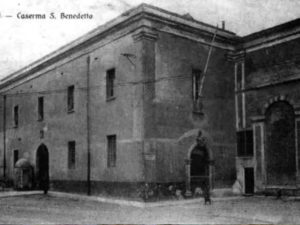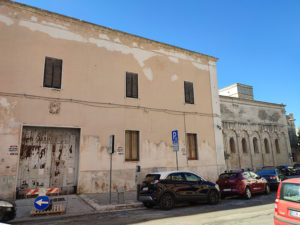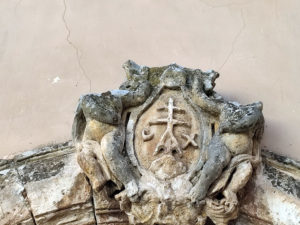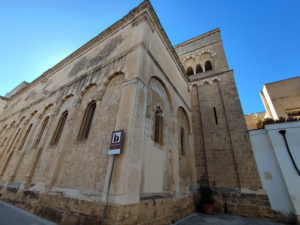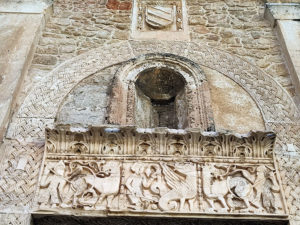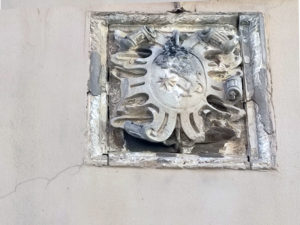I Normanni a Brindisi
Monastero delle monache benedettine, sec. XI – XII, eretto sui resti di un monastero basiliano distrutto dai saraceni nel IX sec.
Il complesso della chiesa e annesso monastero di S. Benedetto furono realizzati in epoca normanna. Nel 1090 il Conte Goffredo e sua moglie Sighelgaida fondarono la chiesa e il monastero delle benedettine, con chiostro annesso che dovette appartenere ad un convento basiliano del secolo VIII (P. Camassa). Probabilmente il chiostro, certamente una delle architetture più antiche della città, già monumento nazionale nel 1910, con le sue colonnine in marmo greco, doveva appartenere ad un antico monastero basiliano distrutto dai saraceni nel IX sec., sulle cui rovine fu costruito il nuovo monastero benedettino ed al cui interno furono ritrovate sepolture del VI – VII sec., oltre ad elementi architettonici Romani, capitelli e rocchi di colonne, visibili ancora oggi in parte dello scavo lasciato a vista.
Il convento fu detto prima di S. Maria Veterana, perché situato in civitate vetere, cioè in un vecchio rione della città, sebbene fosse in suburbia, come ci dice il Vacca sulla base di quanto riportato nel Codice Diplomatico di Annibale De Leo.
Il convento delle monache di San Benedetto fu detto delle monache nere con riferimento al colore della veste, per distinguerlo da quello delle monache Premonstratensi, seguaci della regola di S. Agostino, che indossavano la veste bianca. Poiché era costume che il patrimonio di famiglia andasse al primogenito, alle donne non sposate si assicurava la sopravvivenza attraverso la vita conventuale, ragione per la quale fiorirono diversi monasteri.
La notte del 20 settembre 1694 il convento prese fuoco e le monache furono accompagnate da Monsignor Ramirez al vicino monastero degli Angeli, annesso all’omonima chiesa. Per questa ragione nel ‘700 il vecchio monastero venne abbandonato e costruito il nuovo collegato alla chiesa attraverso un vano di passaggio. L’originaria facciata della chiesa venne occlusa ed il potale fu smontato e ricostruito sulla parete laterale, dove si può ammirare ancora oggi.
Testimonianza dell’antico monastero è il prezioso Arco del Parlatorio, esemplare lapideo dell’Ordine dei benedettini, con lo stemma che riproduce una Croce di Lorena probabilmente su un calvario, o piedistallo, mentre sull’accesso principale del complesso vi è un altro stemma lapideo.
Con la dismissione del patrimonio ecclesiastico a valle dell’unità d’Italia, il convento passò al demanio, che vi istituì il comando della Polizia municipale (fig.1), operando importanti rifacimenti e dismesso in epoca recente.
Note Bibliografiche:
– Pasquale Camassa, Guida di Brindisi, ristampa a cura di AGM srl, Lecce, 1999
– Rosanna Alaggio, Il Medioevo nelle città italiane – Brindisi, Fondazione Centro Italiano di Studi sull’Alto Medioevo, Spoleto, 2015
– Alberto Del Sordo, Toponomastica brindisina, il centro storico, Schena ed., Fasano (Br) 1990
– Gianfranco Perri, Brindisi nel contesto della storia, ed. Lulu.com, 2016
– Nicola Vacca, Brindisi ignorata, ed. Vecchi & C., Trani (BA), 1954
– Giacomo Carito, Brindisi Nuova Guida, Ed. Prima 1993-4
The Normans in Brindisi
Monastery of Benedictine nuns, XI – XII century. Built on the ruins of an ancient Basilian monastery, destroyed by Saracens in the IX century.
The complex of the church and the annexed monastery of S. Benedetto were built in the Norman age. In the year 1090 the Count Goffredo and his wife Sighelgaida founded the Benedictine church and the monastery, with a cloister with Greek marble columns. Likely, the cloister had belonged to an ancient Basilian convent dated back to the VIII century (P. Camassa), then destroyed by Saracens in the IX century. It is one of the most ancient buildings of the city, already declared national monument in 1910. Inside it were found sepulchers of the VI – VII century and Roman architectural elements, like capitals and columns drums, still visible today in a portion of the exposed excavation.
The Convent was named S. Maria Veterana, because sited in civtate vetere. This place was an old district of the city, even though it was in “suburbia”, as Vacca says on the basis of what reported in the Annibale De Leo’s Diplomatic Code.
The Benedictine nuns’ convent was also called “of the black nuns”, with reference to the color of their dress. The black color was chosen to distinguish the order from the Premonstrate nuns one, which dressed a white dress to follow the rule of S. Agostino. The tradition provided that the family fortune should be given to the firstborn, unmarried women were destined to the monastic life, to assure their survival. This is the reason why several monasteries flourished. In the night of the 20th of September 1694, the convent caught fire and nuns were accompanied by Monsignor Ramirez to the near monastery degli Angeli, annexed to the homonymous church. For this reason, the old monastery was abandoned and the new one was built, connected to the church through a passageway. The original façade of the church was then occluded, and the portal disassembled and reconstructed on the side wall, where is still admirable today.
Evidence of the ancient monastery is the valuable Arch “del Parlatorio”, a stone Benedictine Order specimen. The coat of arms reproduces a Croce di Lorena, probably on a calvary or pedestal. On the main entrance of the complex there is another stone coat of arms. With the disposal of the ecclesiastic fortune, due to the Unification of Italy, the convent became of state property. There was located the Command of the Municipal Police (fig. 1), renovating the building, which has been demised in recent times.
Bibliographic notes:
– Pasquale Camassa, Guida di Brindisi, ristampa a cura di AGM srl, Lecce, 1999
– Rosanna Alaggio, Il Medioevo nelle città italiane – Brindisi, Fondazione Centro Italiano di Studi sull’Alto Medioevo, Spoleto, 2015
– Alberto Del Sordo, Toponomastica brindisina, il centro storico, Schena ed., Fasano (Br) 1990
– Gianfranco Perri, Brindisi nel contesto della storia, ed. Lulu.com, 2016
– Nicola Vacca, Brindisi ignorata, ed. Vecchi & C., Trani (BA), 1954
– Giacomo Carito, Brindisi Nuova Guida, Ed. Prima 1993-4

